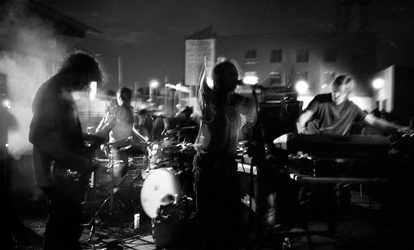Gang Gang Dance, Gang Gang Dance performance, 2007.
Founded 2001–02 in New York, New York, by Lizzi Bougatsos, Brian DeGraw, Tim DeWit, Josh Diamond, and Nathan Maddox
Engaging primarily as a rock group, Gang Gang Dance’s interdisciplinary practice challenges expectations implicit to the music genre, reconfiguring the typical notion of a band into what they call a “band of outsiders.” With interests collectively encompassing dance, performance art, theater, DJing, film, and visual art, they play gigs as often in galleries, museums, and art fairs as they do at nightclubs and music festivals. Besides rejecting industry limitations, Gang Gang Dance subject their musical practice to stringent laws of free-spiritedness, assimilating a wide array of international sounds into their new breed of world music. Beats and melodies from every continent are sampled, processed through synthesizers and computers, and looped into pulsating rhythms that pull from ancient traditions while offering a contemporary, foreign sound. Their ability to reinvigorate potentially repetitive 4/4 rock beats with an ear toward global syncretism links them to experimental bands like Sun City Girls, who collected field samples from radio and live performance around the planet, though Gang Gang Dance are more groove oriented. Having shared studio spaces with Animal Collective and Black Dice, Gang Gang Dance also share a futuristic noise aesthetic inspired by New York’s recent musical history, from 1970s avant-garde musicians like Yoko Ono to the 1980s no wave scene.
Gang Gang Dance’s attempts to control the sonic chaos they create results in dense tonal collages overlapped by luscious, echoing vocals. Drummer and singer Lizzi Bougatsos, frequently compared to Kate Bush for her slightly goth, birdlike trill, keyboardist and electronic percussionist Brian DeGraw, drummer Tim DeWit, and guitarist Josh Diamond describe their music as somewhat “devotional” in commemoration of member Nathan Maddox, killed by lightning strike in 2002. Their recent records God’s Money (2005) and RAWWAR (2007) express a joie de vivre inspired by Maddox’s life and death; Retina Riddim (2007), a visual project by DeGraw, particularly harnesses this impassioned energy.
Retina Riddim is a 30-minute DVD project combining video and sound into an abstract documentary of Gang Gang Dance’s rich history. Found and live footage and interview clips pieced together alongside shots of friends and fans are accompanied by a mixed soundtrack of live recordings, field recordings, practice tapes, and previously released work. Though the film opens with trance-inducing, mellow sequences, other moments barrage the viewer into a pleasant state of sensory overload. A loose, painterly narrative unfolding through a multiplicity of short clips reveals a sense of the band’s interactions with their audience and among themselves. By evolving Gang Gang Dance’s visual aesthetic, Rettina Riddim embodies their belief that music is integral to all art forms. TRINIE DALTON
Gang Gang Dance, Gang Gang Dance performance, 2007. Courtesy Georg Gatsas.

























